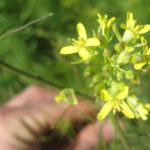
If you’re looking to make use of local wild greens, why not give tumblemustard a try? Tumblemustard (Sisymbrium altissimum)—a non-native species from the Middle East thought to have been introduced to North America years ago via contaminated crop seed—is found throughout much of the world, including the continental U.S. and Canada. It can be quite common on deteriorated Western range lands.
You probably know tumblemustard best as one of a group of plants called “tumbleweeds” that detach from their dry stalks at maturity and tumble across the plains on the wind. To make use of fresh tumblemustard greens, however, you need to identify the plant while it is young and lush.


Tumblemustard, like other mustards, produces a basal rosette of greens. When it lays prostrate on the ground it looks like a fantastic jaggedy pinwheel. The pinnately lobed leaves vary in form, with the lower leaves bearing larger, deep lobes that range from smooth-margined near the tip to toothy near the base. Upper leaves are deeply dissected, but bear thin, spindly lobes, giving them a wispy appearance.
When tumblemustard begins to bolt and the leaves rise up off the ground, they can be lush and lovely for a spell—perfect for a salad. They are somewhat fuzzy in texture, so I like to chop them up and mix them with other greens.
Shortly thereafter, when flower buds form atop the bolted plant inside a burst of spindly leaves, you can clip the whole top off and blanch or boil it to use as a cooked vegetable. Or you can chop this part up too and throw it raw into a salad. The flavor ranges from mild to spicy with a mustardy kick. The thin leaves surrounding the mustard heads are of a fine consistency, as are the tender top portions of the stem. Break the stem above where it toughens up, which you can figure out by simply bending the stalk—the same method recommended to asparagus-pickers.
Foraging author Samuel Thayer explains that the meristem, or fastest growing portion of a plant, is the part of a plant you want to eat (Nature’s Garden, 2010). That is when and where the vegetable is at its best for flavor, calories, and texture.
I recently collected some nice tumblemustard greens in Manitou Springs and north Denver, Colorado, so the season is on for foragers in these and comparable regions. We even get tumblemustard up here at 10,000 feet in Fairplay where I live, though a bit later.
Safe practice dictates that if you are unfamiliar with tumblemustard or plants in general and uncertain of your identification, don’t eat it the first time you identify it. Run it by an expert, or wait and watch the plant through a season. If your tentative ID is correct, the mustard will branch many times as it grows, beginning to assume the round-ish form that as a mature plant will eventually break off and tumble on the wind. It will produce small, lemony-yellow, four-petaled flowers. The fruit/seedpods are long and skinny and protrude in a raceme from the stems.
Not too many people write of tumblemustard edibility, but it is indeed edible and in my opinion not bad eating—just so long as you catch the season right and gather it in a good stage of growth. That said, the flavor can be strong and a little can go a long way, so proceed carefully when adding it to mixed dishes.
Sometimes we foragers get zany for a particular wild food treasure—morel mushrooms or wild leeks, for example. But let us not forget that there are humbler finds to be had, green staples growing in abundance that we can easily incorporate into our seasonal fare. In the case of common non-native species like tumblemustard, there’s the added bonus that we might even be helping native ecology by eating them.
Updated 2.22.21





I saw a lot of it getting frilly already this weekend. Once I finish processing all the food in my fridge, I’m going to enjoy a bunch of tumblemustard. Thanks for this informative article.
How can I obtain a hard copy? I would like to go out in the field with photographs so I can compare and identify. I liked this very much and for a change was not assailed with a lot of unnecessary frills.